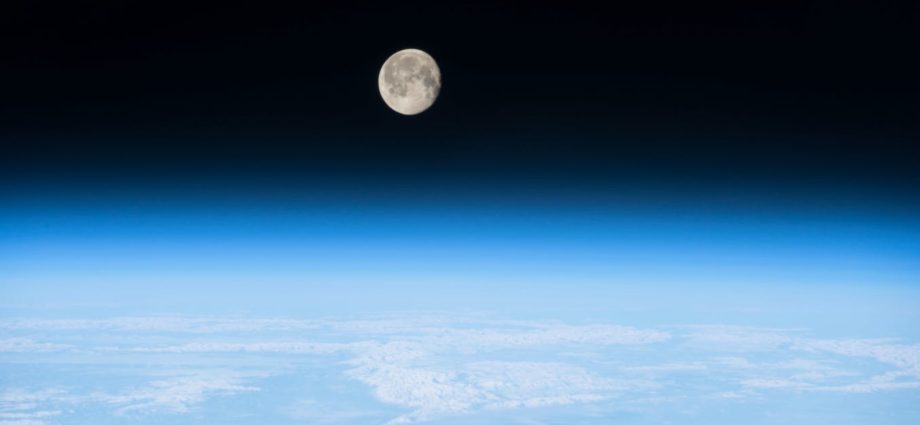Life on Earth: why we may have the Moon’s now defunct magnetic field to thank for it
Photo of a nearly full Moon shining brightly on the Earth’s atmosphere, taken from the International Space Station. NASA
Christopher Davies, University of Leeds and Jon Mound, University of Leeds
The habitability of a planet depends on many factors. One is the existence of a strong and long-lived magnetic field. These fields are generated thousands of kilometres below the planet’s surface in its liquid core and extend far into space – shielding the atmosphere from harmful solar radiation.
Without a strong magnetic field, a planet struggles to hang on to a breathable atmosphere – which is bad news for life as we know it. A new study, published in Science Advances, suggests that the Moon’s now extinct magnetic field may have helped protect our planet’s atmosphere as life was forming around 4 billion years ago.
Today, Earth has a strong global magnetic field that protects the atmosphere and low-orbiting satellites from harsh solar radiation. In contrast, the Moon does not possess either a breathable atmosphere or a global magnetic field.
Global magnetic fields are generated by the motion of molten iron in the cores of planets and moons. Keeping the fluid moving requires energy, such as heat trapped within the core. When there is insufficient energy, the field dies.
Without a global magnetic field, the charged particles of the solar wind (radiation from the Sun) passing close to a planet generate electric fields that can accelerate charged atoms, known as ions, out of the atmosphere. This process is happening today on Mars and it is losing oxygen as a result – something that has been directly measured by the Mars atmosphere and volatile evolution (Maven) mission. The solar wind can also collide with the atmosphere and knock molecules into space.
The Maven team estimates that the amount of oxygen lost from the Martian atmosphere throughout its history is equivalent to that contained in a global layer of water, 23 metres thick.
Probing ancient magnetic fields
The new research investigates how the Earth’s and Moon’s early fields may have interacted. But probing these ancient fields isn’t easy. Scientists rely on ancient rocks that contain small grains that got magnetised as the rocks formed, saving the direction and strength of the magnetic field at that time and place. Such rocks are rare and extracting their magnetic signal requires careful and delicate laboratory measurement.

Such studies have, however, unveiled that Earth has generated a magnetic field for at least the last 3.5 billion years, and possibly as far back as 4.2 billion years, with a mean strength just over half of the present-day value. We don’t know much about how the field was behaving any earlier than that.

By contrast, the Moon’s field was perhaps even stronger than Earth’s around 4 billion years ago, before precipitously declining to a weak field state by 3.2 billion years ago. At present, little is known about the structure or time-variability of these ancient fields, though.
Another complexity is the interaction between the early lunar and geomagnetic fields. The new paper, which modelled the interaction of two magnetic fields with north poles either aligned or opposite, shows that the interaction extends the region of near-Earth space between our planet and the Sun that is shielded from the solar wind.
The new study is an interesting first step towards understanding how important such effects would be when averaged over a lunar orbit or the hundreds of millions of years that are important for assessing planetary habitability. But to know for sure we need further modelling and more measurements of the strengths of the Earth and Moon’s early magnetic fields.
What’s more, a strong magnetic field does not guarantee the continued habitability of a planet’s atmosphere – its surface and deep interior environments matter too, as do influences from space. For example, the brightness and activity of the Sun has evolved over billions of years and so has the ability of the solar wind to strip atmospheres.
Subscribe to our newsletter.
How each of these factors contributes to the evolution of planetary habitability, and hence life, is still not fully understood. Their nature and how they interact with each other are also likely to change over geological timescales. But thankfully, the latest study has added another piece to an already fascinating puzzle.
Christopher Davies, Associate Professor in Theoretical Geophysics, University of Leeds and Jon Mound, Associate Professor of Geophysics, University of Leeds
This article is republished from The Conversation under a Creative Commons license. Read the original article.

